#commission advocacy
Explore tagged Tumblr posts
Text
An open letter to the U.S. Congress
January 6 Insurrection
3 so far! Help us get to 5 signers!
Please support a bipartisan commission to investigate the January 6, 2021 insurrection at the Capitol.
In my lifetime, I have never before been so aware of the date the electoral college votes were formally counted to validate a Presidential election.
The day is well-documented — video, photos, sworn testimony of witnesses and rioters, a noose was hung for then Vice President Pence, elected officials barricaded doors and vacated chambers, the Confederate flag was marched into the capitol, the list goes on — 5 people died, $30,000,000 of damage was done. Watching the events unfold that day, I was terrified for our elected officials, terrified for our democracy and horrified by the unhinged insurrectionists. What have we become?
Please do what is right for our democracy and support a bipartisan commission to investigate the January 6 insurrection.
▶ Created on May 19, 2021 by Kathryn
📱 Text SIGN PBYCVZ to 50409
🤯 Liked it? FOLLOW KATE.RESIST
#kate.resist#PBYCVZ#resistbot#jan 6 2021#January 6#U.S. Congress#Capitol insurrection#bipartisan commission#democracy defense#electoral vote count#insurrection investigation#Capitol riots#domestic terrorism#rule of law#accountability#political violence#justice for January 6#preserving democracy#congressional action#national security#threat to democracy#Capitol breach#electoral process protection#U.S. democracy crisis#investigating insurrection#protecting officials#rioter accountability#bipartisan support#commission advocacy#Capitol siege
5 notes
·
View notes
Text
USA please listen to me: the price of “teaching them a lesson” is too high. take it from New Zealand, who voted our Labour government out in the last election because they weren’t doing exactly what we wanted and got facism instead.
Trans rights are being attacked, public transport has been defunded, tax cuts issued for the wealthy, they've mass-defunded public services, cut and attacked the disability funding model, cut benefits, diverted transport funding to roads, cut all recent public transport subsidies, cancelled massive important infrastructure projects like damns and ferries (we are three ISLANDS), fast tracked mining, oil, and other massive environmentally detrimental projects and gave the power the to approve these projects singularly to three ministers who have been wined and dined by lobbyists of the companies that have put the bids in to approve them while one of the main minister infers he will not prioritise the protection of endangered species like the archeys frog over mining projects that do massive environmental harm. They have attacked indigenous rights in an attempt to negate the Treaty of Waitangi by “redefining it”; as a backup, they are also trying to remove all mentions of the treaty from legislation starting with our Child Protection laws no longer requiring social workers to consider the importance of Maori children’s culture when placing those children; when the Waitangi Tribunal who oversees indigenous matters sought to enquire about this, the Minister for Children blocked their enquiry in a breach of comity that was condemned in a ruling — too late to do anything — by our Supreme Court. They have repealed labour protections around pay and 90 day trials, reversed our smoking ban, cancelled our EV subsidy, cancelled our water infrastructure scheme that would have given Maori iwi a say in water asset management, cancelled our biggest city’s fuel tax, made our treasury and inland revenue departments less accountable, dispensed of our Productivity Commission, begun work on charter schools and military boot camps in an obvious push towards privatisation, cancelled grants for first home buyers, reduced access to emergency housing, allowed no cause evictions, cancelled our Maori health system that would have given Maori control over their own public medical care and funding, cut funding of services like budgeting advice and food banks, cancelled the consumer advocacy council, cancelled our medicine regulations, repealed free prescriptions, deferred multiple hospital builds, failed to deliver on pre-election medical promises, reversed a gun ban created in response to the mosque shootings, brought back three strikes = life sentence policy, increased minimum wage by half the recommended amount, cancelled fair pay for disabled workers, reduced wheelchair services, reversed our oil and gas exploration ban, cancelled our climate emergency fund, cut science research funding including climate research, removed limits on killing sea lions, cut funding for the climate change commission, weakened our methane targets, cancelled Significant National Areas protections, have begun reversing our ban on live exports. Much of this was passed under urgency.
It’s been six months.
18K notes
·
View notes
Text
URGENT: 🚨🚨EARN IT ACT IS BACK IN THE SENATE 🚨🚨 TUMBLR’S NSFW BAN HITTING THE ENTIRE INTERNET THIS SUMMER 2023
April 28, 2023
I’m so sorry for the long post but please please please pay attention and spread this
What is the EARN IT Act?
The EARN IT Act (s. 1207) has been roundly condemned by nearly every major LGBTQ+ advocacy and human rights organization in the country.
This is the third time the Senate has been trying to force this through, and I talked about it last year. It is a bill that claims "protects children and victims against CSAM" by creating an unelected and politically appointed national commission of law enforcement specialists to dictate "best practices" that websites all across the nation will be forced to follow. (Keep in mind, most websites in the world are created in the US, so this has global ramifications). These "best practices" would include killing encryption so that any law enforcement can scan and see every single message, dm, photo, cloud storage, data, and any website you have every so much as glanced at. Contrary to popular belief, no they actually can't already do that. These "best practices" also create new laws for "removing CSAM" online, leading to mass censorship of non-CSAM content like what happened to tumblr. Keep in mind that groups like NCOSE, an anti-LGBT hate group, will be allowed on this commission. If websites don't follow these best practices, they lose their Section 230 protections, leading to mass censorship either way.
Section 230 is foundational to modern online communications. It's the entire reason social media exists. It grants legal protection to users and websites, and says that websites aren't responsible for what users upload online unless it's criminal. Without Section 230, websites are at the mercy of whatever bullshit regulatory laws any and every US state passes. Imagine if Texas and Florida were allowed to say what you can and can't publish and access online. That is what will happen if EARN IT passes. (For context, Trump wanted to get rid of Section 230 because he knew it would lead to mass govt surveillance and censorship of minorities online.)
This is really not a drill. Anyone who makes or consume anything “adult” and LGBT online has to be prepared to fight Sen. Blumenthal’s EARN IT Act, brought back from the grave by a bipartisan consensus to destroy Section 230. If this bill passes, we’re going to see most, if not all, adult content and accounts removed from mainstream platforms. This will include anything related to LGBT content, including SFW fanfiction, for example. Youtube, Twitter, Reddit, Tiktok, Tumblr, all of them will be completely gutted of anything related to LGBT content, abortion healthcare, resources for victims of any type of abuse, etc. It is a right-wing fascists wet dream, which is why NCOSE is behind this bill and why another name for this bill is named in reference to NCOSE.
NCOSE used to be named Morality in Media, and has rebranded into an "anti-trafficking" organization. They are a hate group that has made millions off of being "against trafficking" while helping almost no victims and pushing for homophobic laws globally. They have successfully pushing the idea that any form of sexual expression, including talking about HEALTH, leads to sex trafficking. That's how SESTA passed. Their goal is to eliminate all sex, anything gay, and everything that goes against their idea of ‘God’ from the internet and hyper disney-fy and sanitize it. This is a highly coordinated attack on multiple fronts.
The EARN IT Act will lead to mass online censorship and surveillance. Platforms will be forced to scan their users’ communications and censor all sex-related content, including sex education, literally anything lgbt, transgender or non-binary education and support systems, aything related to abortion, and sex worker communication according to the ACLU. All this in the name of “protecting kids” and “fighting CSAM”, both of which the bill does nothing of the sort. In fact it makes fighting CSEM even harder.
EARN IT will open the way for politicians to define the category of “pornography" as they — or the lobbies that fund them — please. The same way that right-wing groups have successfully banned books about race and LGBT, are banning trans people from existing, all under the guise of protecting children from "grooming and exploitation", is how they will successfully censor the internet.
As long as state legislatures can tie in "fighting CSAM" to their bullshit laws, they can use EARN IT to censor and surveill whatever they want.
This is already a nightmare enough. But the bill also DESTROYS ENCRYPTION, you know, the thing protecting literally anyone or any govt entity from going into your private messages and emails and anything on your devices and spying on you.
This bill is going to finish what FOSTA/SESTA started. And that should terrify you.
Senator Blumenthal (Same guy who said ‘Facebook should ban finsta’) pushed this bill all of 2020, literally every activist (There were more than half a million signatures on this site opposing this act!) pushed hard to stop this bill. Now he brings it back, doesn’t show the text of the bill until hours later, and it’s WORSE. Instead of fixing literally anything in the bill that might actually protect kids online, Bluemnthal is hoping to fast track this and shove it through, hoping to get little media attention other than propaganda of “protecting kids” to support this shitty legislation that will harm kids. Blumental doesn't care about protecting anyone, and only wants his name in headlines.
It will make CSAM much much worse.
One of the many reasons this bill is so dangerous: It totally misunderstands how Section 230 works, and in doing so (as with FOSTA) it is likely to make the very real problem of CSAM worse, not better. Section 230 gives companies the flexibility to try different approaches to dealing with various content moderation challenges. It allows for greater and greater experimentation and adjustments as they learn what works – without fear of liability for any “failure.” Removing Section 230 protections does the opposite. It says if you do anything, you may face crippling legal liability. This actually makes companies less willing to do anything that involves trying to seek out, take down, and report CSAM because of the greatly increased liability that comes with admitting that there is CSAM on your platform to search for and deal with. This liability would allow anyone for any reason to sue any platform they want, suing smaller ones out of existence. Look at what is happening right now with book bans across the nation with far right groups. This is going to happen to the internet if this bill passes.
(Remember, the state department released a report in December 2021 recommending that the government crack down on “obscenity” as hard the Reagan Administration did. If this bill passes, it could easily go way beyond shit red states are currently trying. It is a goldmine for the fascist right that is currently in the middle of banning every book that talks about race and sexuality across the US.)
The reason these bills keep showing up is because there is this false lie spread by organizations like NCOSE that platforms do nothing about CSEM online. However, platforms are already liable for child sexual exploitation under federal law. Tech companies sent more than 45 million+ instances of CSAM to the DOJ in 2019 alone, most of which they declined to investigate. This shows that platforms are actually doing everything in their power already to stop CSEM by following already existing laws. The Earn It Act includes zero resources for proven investigation or prevention programs. If Senator Bluementhal actually cared about protecting youth, why wouldn’t he include anything to actually protect them in his shitty horrible bill? EARN IT is actually likely to make prosecuting child molesters more difficult since evidence collected this way likely violates the Fourth Amendment and would be inadmissible in court.
I don’t know why so many Senators are eager to cosponsor the “make child pornography worse” bill, but here we are.
HOW TO FIGHT BACK
EARN IT Act was introduced just two weeks ago and is already being fast-tracked. It will be marked up the week of May 1st and head to the Senate floor immediately after. If there is no loud and consistent opposition, it will be law by JUNE! Most bills never go to markup, so this means they are putting pressure to move this through. There are already 20 co-sponsors, a fifth of the entire Senate. This is an uphill battle and it is very much all hands on deck.
CALL YOUR REPRESENTATIVES.
This website takes you to your Senator / House members contact info. EMAIL, MESSAGE, SEND LETTERS, CALL CALL CALL CALL CALL. Calling is the BEST way to get a message through. Get your family and friends to send calls too. This is literally the end of free speech online.
(202) 224-3121 connects you to the congressional hotline. Here is a call script if you don't know what to say. Call them every day. Even on the weekends, leaving voicemails are fine.
2. Sign these petitions!
Link to Petition 1
Link to Petition 2
3. SPREAD THE WORD ONLINE
If you have any social media, spread this online. One of the best ways we fought back against this last year was MASSIVE spread online. Tiktok, reddit, twitter, discord, whatever means you have at least mention it. We could see most social media die out by this fall if we don't fight back.
Here is a linktree with more information on this bill including a masterpost of articles, the links to petitions, and the call script.
DISCORD LINK IF YOU WANT TO HELP FIGHT IT
TLDR: The EARN IT Act will lead to online censorship of any and all adult & lgbt content across the entire internet, open the floodgates to mass surveillance the likes which we haven’t seen before, lead to much more CSEM being distributed online, and destroy encryption. Call 202-224-3121 to connect to your house and senate representative and tell them to VOTE NO on this bill that does not protect anyone and harms everyone.
43K notes
·
View notes
Text
In general, I think it's currently really important for progressive Christians to be very loud about being both progressive and deeply religious Christians, and for everyone else fighting for progressive values to be supportive of them doing just that. I know that's like, idk, counter-intuitive or cringe or whatever, but seriously folks, the alternative is that progressive Christians have to be quiet about their faith to be accepted within broader secular and interfaith progressive advocacy, which means that the regressive asshole Christians (a) sound that much louder and (b) dominate the USian religious landscape all the more. That's a problem, for all of us.
We need people pushing back within the faith as well as outside of it, because that destroys any edifice that this is about Christianity and religious freedom.
You can be a devout Christian and also:
Openly, proudly, and without being forced to remain celibate or otherwise limit your full expression of self, identify as LGBTQ+ or be a supportive ally.
Advocate for full reproductive autonomy and comprehensive sex education.
Love and support people of other religious groups, non-religious people and/or atheists, by choosing to believe that a truly loving God would not pursue anything less than universal salvation.
Stand against evangelism and proselytizing as they have thus far been interpreted and used, because there are ways to interpret the Great Commission that don't promote colonialism and cultural genocide.
A steward of the earth, protecting God's beautiful creation and lovingly tending to it as the unique and incredible gift that it is.
A believer in science, rationalism, and human progress as part of God's divine plan for humanity.
A believer in history and someone who understands that the Bible can be both divinely given and open to interpretation (no really)(if you're confused, please talk to a knowledgeable traditional Jew)
An ally to Jews, who stands against supercessionism and antisemitism in the church.
And in before regressive Christians come shouting at me that (1) what do I know, I'm a Jew and (2) no lol you can't because of ___ reason:
My source is that I've personally met and talked to Christians of great faith and integrity - people who embody the closest forms of kindness I've seen to what Jesus himself advocated - who are each of these things.
It is 100% possible; you just choose to believe otherwise.
13K notes
·
View notes
Text
The Klamath River’s salmon population has declined due to myriad factors, but the biggest culprit is believed to be a series of dams built along the river from 1918 to 1962, cutting off fish migration routes.
Now, after decades of Indigenous advocacy, four of the structures are being demolished as part of the largest dam removal project in United States history. In November, crews finished removing the first of the four dams as part of a push to restore 644 kilometres (400 miles) of fish habitat.
“Dam removal is the largest single step that we can take to restore the Klamath River ecosystem,” [Barry McCovey, a member of the Yurok Tribe and director of tribal fisheries,] told Al Jazeera. “We’re going to see benefits to the ecosystem and then, in turn, to the fishery for decades and decades to come.” ...
A ‘watershed moment’
Four years later, [after a catastrophic fish die-off in 2002,] in 2006, the licence for the hydroelectric dams expired. That created an opportunity, according to Mark Bransom, CEO of the Klamath River Renewal Corporation (KRRC), a nonprofit founded to oversee the dam removals.
Standards for protecting fisheries had increased since the initial license was issued, and the utility company responsible for the dams faced a choice. It could either upgrade the dams at an economic loss or enter into a settlement agreement that would allow it to operate the dams until they could be demolished.
“A big driver was the economics — knowing that they would have to modify these facilities to bring them up to modern environmental standards,” Bransom explained. “And the economics just didn’t pencil out.”
The utility company chose the settlement. In 2016, the KRRC was created to work with the state governments of California and Oregon to demolish the dams.
Final approval for the deal came in 2022, in what Bransom remembers as a “watershed moment”.
Regulators at the Federal Energy Regulatory Commission (FERC) voted unanimously to tear down the dams, citing the benefit to the environment as well as to Indigenous tribes...
Tears of joy
Destruction of the first dam — the smallest, known as Copco 2 — began in June, with heavy machinery like excavators tearing down its concrete walls.
[Amy Cordalis, a Yurok Tribe member, fisherwoman and lawyer for the tribe,] was present for the start of the destruction. Bransom had invited her and fellow KRRC board members to visit the bend in the Klamath River where Copco 2 was being removed. She remembers taking his hand as they walked along a gravel ridge towards the water, a vein of blue nestled amid rolling hills.
“And then, there it was,” Cordalis said. “Or there it wasn’t. The dam was gone.”
For the first time in a century, water flowed freely through that area of the river. Cordalis felt like she was seeing her homelands restored.
Tears of joy began to roll down her cheeks. “I just cried so hard because it was so beautiful.”
The experience was also “profound” for Bransom. “It really was literally a jolt of energy that flowed through us,” he said, calling the visit “perhaps one of the most touching, most moving moments in my entire life”.
Demolition on Copco 2 was completed in November, with work starting on the other three dams. The entire project is scheduled to wrap in late 2024.
[A resilient river]
But experts like McCovey say major hurdles remain to restoring the river’s historic salmon population.
Climate change is warming the water. Wildfires and flash floods are contaminating the river with debris. And tiny particles from rubber vehicle tires are washing off roadways and into waterways, where their chemicals can kill fish within hours.
McCovey, however, is optimistic that the dam demolitions will help the river become more resilient.
“Dam removal is one of the best things we can do to help the Klamath basin be ready to handle climate change,” McCovey explained. He added that the river’s uninterrupted flow will also help flush out sediment and improve water quality.
The removal project is not the solution to all the river’s woes, but McCovey believes it’s a start — a step towards rebuilding the reciprocal relationship between the waterway and the Indigenous people who rely on it.
“We do a little bit of work, and then we start to see more salmon, and then maybe we get to eat more salmon, and that starts to help our people heal a little bit,” McCovey said. “And once we start healing, then we’re in a place where we can start to help the ecosystem a little bit more.”"
-via Al Jazeera, December 4, 2023
#indigenous#river#riverine#ecosystem#ecosystem restoration#klamath#klamath river#oregon#california#yurok#fishing#fisheries#nature is healing#literally this time lol#united states#dam removal#climate change#conservation#sustainability#salmon#salmon run#water quality#good news#hope#rewilding#ecology#environment
5K notes
·
View notes
Text
Nigeria’s elections critical to Liberian, Sierra Leonean 2023 polls – West African coalition
A regional coalition of pro-democracy civil society organisations has said Nigeria’s general elections have implications for similar polls taking place in two West African countries within the year. The two other West African countries are Sierra Leone and Liberia. The West Africa Democracy Solidarity Network (WADEMOS) said this on Friday during its four-day official visit to Nigeria. The…
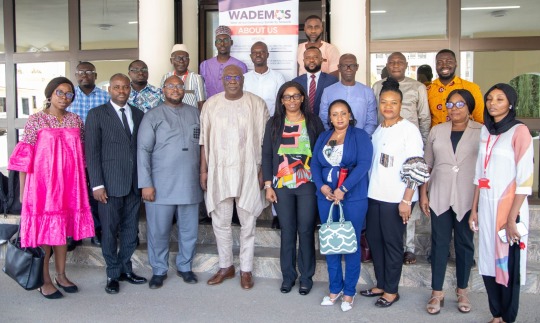
View On WordPress
#Advocacy and Policy Engagement#Ghana#Independent National Electoral Commission (INEC)#Inter-Party Advisory Council (IPAC)#National Assembly Elections#the Centre for Democracy and Development (CDD)#West Africa Democracy Solidarity Network (WADEMOS)
0 notes
Text

Fandom Trumps Hate 2025 is coming!
Fandom Trumps Hate is ramping up for its ninth year, and I'm hoping you'll join me in participating! Over the next couple of weeks I'm going to be posting about this event, different ways to be involved, and keeping you apprised of important dates as they arrive. To start -- a quick FAQ!
What is Fandom Trumps Hate?
Fandom Trumps Hate (or FTH for short) is a massive cross-fandom auction of fanworks for charity. Contributors sign up to offer a digital (or sometimes physical!) creation, and bidders agree to donate an amount to selected charitable organizations. Over the past 8 years, they (and the hundreds of creators and bidders who have participated) have raised over $300,000 for dozens of organizations doing important work in fields including LGBTQ+ rights, housing insecurity, voting advocacy, racial inequality, environmental issues, and more.
What kinds of things can be in the auction?
Anything you can imagine and create! Most of the auctions are digital content, but there is also the Craft Bazaar for physical items. And even within the digital offerings, there's a ton of variety -- fanfics are one of the more popular, but there's also fanart, fan labor (such as beta-ing, region-picking or expertise-picking, coding, etc.), podfics, music, gifmaking, and more!
What are the key dates I should know about?
Creator signups are from Monday, January 20th to Sunday, February 2nd
On Friday, February 21st, the auctions will all be posted for bidders to peruse before the bidding period
Auction bidding is from Tuesday, February 25th at 8am EST to Saturday, March 1st at 8pm EST
Is auctioning off fanworks even legal?
I mean, technically everything in fanwork is a bit of a legal grey area, loosely protected by fair use. The key here is that the creators are not "selling" fanworks, nor are bidders "commissioning" the fanworks -- no money ever goes from bidder to creator, only from bidder to charitable organization. Instead, these fanworks are gifts to thank the bidders for their donation.
I have another question?
I'll be making a few more posts with more information, but please feel free to drop me an ask or slide into my DMs, and I'll help as best I can! You can also check out the @fandomtrumpshate tumblr for more information, or reach out to them via email at [email protected].
136 notes
·
View notes
Text
[“The return of the salmon comes less than two months after the end of the dam removals in California and Oregon, an effort that took decades of advocacy by the surrounding tribes—including the Yurok, Karuk, Shasta, Klamath and Hoopa Valley, among others—whose people have deep ties to the Chinook salmon.
Ron Reed, a Karuk tribe member and traditional fisherman, participated in the campaigns for dam removal, advocating that the river’s restoration would help salmon recover. He isn’t surprised the fish have returned so quickly to their ancestral waters, he tells the Los Angeles Times’ Ian James.
“The fact that the fish are going up above the dams now, to the most prolific spawning and rearing habitat in North America, it definitely shines a very bright light on the future,” Reed tells the Los Angeles Times. “Because with those dams in place, we were looking at extinction. We were looking at dead fish.”
In one poignant case, tens of thousands of Chinook salmon died off in the span of days in 2002, as the water quality in the dammed Klamath River deteriorated from the lack of flow. The dams, built between the early 1900s and 1962, also contributed to algae blooms and diseases, and they blocked the salmon’s annual migration.
The mass salmon deaths helped spark decades of advocacy from Klamath tribes and conservation groups. In November 2022, the Federal Energy Regulatory Commission approved the $500 million project. The first dam to be destroyed, Copco No. 2, came down in fall 2023. Beginning in January this year, the remaining three dams had their reservoirs drained and their infrastructure removed. For the first time in more than a century, the river flowed freely by the end of August.
167 notes
·
View notes
Text
End Gerrymandering! Pass the FAIR MAPS Act!
AN OPEN LETTER to THE U.S. CONGRESS
593 so far! Help us get to 1,000 signers!
Rep. Wiley Nickel has introduced a bill, the FAIR MAPS Act, to combat partisan gerrymandering by establishing independent, non-partisan redistricting commissions in every state. I’d like you to support it.
Across the country, partisan gerrymandering has been used as a tool by politicians to manipulate electoral outcomes with almost surgical precision. This leads to hyper-partisanship, a lack of trust in government, and disenfranchised voters. In America today, politicians too often choose their voters instead of voters choosing their elected officials. It's troubling and anti-democratic.
Independent redistricting commissions, which the FAIR MAPS Act promotes, are a common-sense solution to gerrymandering that puts power in the hands of the people – where it belongs. When districts are drawn fairly, all voters – Republicans, Democrats, and independents alike – have a fair shot to make their voices heard.
For that reason, please co-sponsor and work to pass the FAIR MAPS Act. Thanks.
▶ Created on April 25 by Jess Craven · 593 signers in the past 7 days
📱 Text SIGN PDXMVG to 50409
🤯 Liked it? Text FOLLOW JESSCRAVEN101 to 50409
#JESSCRAVEN101#PDXMVG#resistbot#End Gerrymandering#Fair Maps#Redistricting Reform#Independent Commissions#Non Partisan Politics#Political Reform#Voting Rights#Democracy In Action#Electoral Fairness#Political Transparency#Gerrymandering Reform#Civic Engagement#Vote Equality#Election Integrity#Representative Democracy#Fair Elections#Political Accountability#Government Reform#Partisan Politics#Voice Of The People#Legislative Action#Civil Rights#Public Advocacy#Campaign For Change#Voter Empowerment#Political Progress#Activism Works
1 note
·
View note
Text

The government of Australia’s northeastern state of Queensland has stunned rights experts by suspending its Human Rights Act for a second time this year to be able to lock up more children.
The ruling Labor Party last month [August 2023] pushed through a suite of legislation to allow under-18s – including children as young as 10 – to be detained indefinitely in police watch houses, because changes to youth justice laws – including jail for young people who breach bail conditions – mean there are no longer enough spaces in designated youth detention centres to house all those being put behind bars. The amended bail laws, introduced earlier this year [2023], also required the Human Rights Act to be suspended.
The moves have shocked Queensland Human Rights Commissioner Scott McDougall, who described human rights protections in Australia as “very fragile”, with no laws that apply nationwide.
“We don’t have a National Human Rights Act. Some of our states and territories have human rights protections [...]. But they’re not constitutionally entrenched so they can be overridden by the parliament,” he told Al Jazeera. The Queensland Human Rights Act – introduced in 2019 – protects children from being detained in adult prison so it had to be suspended for the government to be able to pass its legislation.
---
Earlier this year, Australia’s Productivity Commission reported that Queensland had the highest number of children in detention of any Australian state. Between 2021-2022, the so-called “Sunshine State” recorded a daily average of 287 people in youth detention, compared with 190 in Australia’s most populous state New South Wales, the second highest. [...]
[M]ore than half the jailed Queensland children are resentenced for new offences within 12 months of their release.
Another report released by the Justice Reform Initiative in November 2022 showed that Queensland’s youth detention numbers had increased by more than 27 percent in seven years.
---
The push to hold children in police watch houses is viewed by the Queensland government as a means to house these growing numbers. Attached to police stations and courts, a watch house contains small, concrete cells with no windows and is normally used only as a “last resort” for adults awaiting court appearances or required to be locked up by police overnight. [...]
However, McDougall said he has “real concerns about irreversible harm being caused to children” detained in police watch houses, which he described as a “concrete box”. “[A watch house] often has other children in it. There’ll be a toilet that is visible to pretty much anyone,” he said. “Children do not have access to fresh air or sunlight. And there’s been reported cases of a child who was held for 32 days in a watch house whose hair was falling out. [...]"
---
He also pointed out that 90 percent of imprisoned children and young people were awaiting trial.
“Queensland has extremely high rates of children in detention being held on remand. So these are children who have not been convicted of an offence,” he told Al Jazeera.
Despite Indigenous people making up only 4.6 percent of Queensland’s population, Indigenous children make up nearly 63 percent of those in detention. The rate of incarceration for Indigenous children in Queensland is 33 times the rate of non-Indigenous children. Maggie Munn, a Gunggari person and National Director of First Nations justice advocacy group Change the Record, told Al Jazeera the move to hold children as young as 10 in adult watch houses was “fundamentally cruel and wrong”. [...]
---
[Critics] also told Al Jazeera that the government needed to stop funding “cops and cages” and expressed concern over what [they] described as the “systemic racism, misogyny, and sexism” of the Queensland Police Service.
In 2019, police officers and other staff were recorded joking about beating and burying Black people and making racist comments about African and Muslim people. The recordings also captured sexist remarks [...]. The conversations were recorded in a police watch house, the same detention facilities where Indigenous children can now be held indefinitely.
Australia has repeatedly come under fire at an international level regarding its treatment of children and young people in the criminal justice system. The United Nations has called repeatedly for Australia to raise the age of criminal responsibility from 10 to the international standard of 14 years old [...].
[MR], Queensland’s minister for police and corrective services, [...] – who introduced the legislation, which is due to expire in 2026 – is unrepentant, defending his decision last month [August 2023].
“This government makes no apology for our tough stance on youth crime,” he was quoted as saying in a number of Australian media outlets.
---
Text by: Ali MC. "Australian state suspends human rights law to lock up more children". Al Jazeera. 18 September 2023. At: aljazeera.com/news/2023/9/18/australian-state-suspends-human-rights-law-to-lock-up-more-children [Bold emphasis and some paragraph breaks/contractions added by me.]
897 notes
·
View notes
Text
Portrait of a Royal
(Warning behind the cut for a full-length image of the new Jonathan Yeo portrait of Charles III, which is real startling if you aren't expecting it.)
"Having met Charles Windsor," Gregory said over breakfast that morning, "I can assure you, he really is exactly the kind of man who wouldn't notice an elaborate and expensive roasting."
They had a rule about reading smartphones at breakfast -- using a tablet was fine if they were talking business, and phones were permitted for scheduling or settling arguments about the lyrics to songs or movie trivia, but overall they tried to keep the devices face-down. On that particular morning absolutely nobody was following the rule, because Jes had walked into the dining room with Michaelis, propped their tablet against a juice carafe in the middle of the table, and said, "I want everyone's opinion on what the actual living fuck is going on here."

Gerald had almost choked on his coffee. Alanna, feeding Sera, had looked up at the tablet, showing a portrait of King Charles III of England done in raw-meat pinks and muddy browns, and missed Sera's face entirely with a spoonful of mashed banana. Joan's eyes went huge as Eddie went into peals of laughter, which the twins promptly imitated, slapping their hands on the trays of their high chairs.
Gregory had carefully set down his silverware and rested his elbows on the table, propping his nose on his clasped hands to try and maintain a poker face.
"It's satire, right?" Ger had asked, looking from Jes to Gregory to Alanna. "I actually liked art history at school, and that's a painting someone did in protest, isn't it?"
"This is the official royally commissioned portrait of Charles the third," Michaelis had said, helping himself to breakfast at the sideboard and settling in between Joan and Jes. "But yes, it is also satire."
"They paid for that?" Eddie asked, gesturing at the painting. "They paid for it. And voluntarily put it on display."
"So the press releases say," Jes said. "I'm taking soundings because we are absolutely dedicating at least one episode of The Echo to it. I might have to start an entirely new podcast about contemporary art just so I can do a deep dive."
"Satire," Gerald repeated, staring at the painting.
"Not explicitly according to the artist, but his description of it is…very dry," Michaelis said. Jes held up their phone and read from it.
"The vivid color of the glazes in the background echo the uniform’s bright red tunic, not only resonating with the royal heritage found in many historical portraits but also injecting a dynamic, contemporary jolt into the genre with its uniformly powerful hue…" they stopped to snicker.
"Oh that's good," Alanna said approvingly. "Calling raw-flesh red the royal heritage is a very nice touch."
"The butterfly approaching King Charles's shoulder in the portrait adds a layer of narrative depth, symbolizing both his known advocacy for environmental causes and his personal transformation."
"It's a lie," Joan said. The adults looked at her.
"What's a lie, hon?" Gregory asked.
"I mean -- " Joan frowned at the painting. "He says he's painting the king's portrait but he's actually painting his feelings about the king, right? And being paid to paint a portrait implies you're supposed to be on the subject's side. But he's definitely not. So it's kind of like a lie. Of a painting. That's cool," she added, thoughtfully. "He roasted the king and the king didn't even notice? That's so cool!"
"Having met Charles Windsor," Gregory said, "I can assure you, he really is exactly the kind of man who wouldn't notice an elaborate and expensive roasting."
"That's sort of what satire is," Gerald added. "It's saying one thing but meaning another in a way that's really obvious to almost everyone."
"Ooh," Joan replied, digesting this. "I've had European history," she continued. "Other royal families aren't like ours."
"Well, some," Michaelis said. "Most, perhaps. Because we elect our royalty, even if we do tend to…elect in families. If you're king one day, it'll be because Gregory trained you and the people think you'd be best at the job. If you were the kind of person he is," he added, nodding to the portrait, "You probably wouldn't get elected."
"I sure wouldn't want a portrait like that done of me if I did," Joan said.
"That reminds me, we really do need to have portraits done," Gregory said to Eddie.
"Well, I say hire this guy," Eddie replied, gesturing at the painting. "At least you know you'll get an honest opinion."
"Doubt he needs the work, given he managed to get paid to insult a king to his face," Jes said. "Maybe that's the angle -- he basically ran a con on the royal family."
"Is it a con if they pay you for something and you give it to them?" Gerald asked.
"To be clear, that was con-parenthesis-admiring-close-parenthesis," Jes replied.
"I should never have told them I have a Tumblr," Ger said to Alanna.
"Don't look at me, I warned you," she replied.
"His other work is very good," Gregory said, scrolling images on his own phone. "I wonder if we can afford him. Love to see what he'd do with you, Eddie."
"I don't mind. Whatever he does, can't be worse than the haters who didn't like my TV show," Eddie replied serenely.
"Am I going to meet the Windsors, ever?" Joan asked Gregory.
"Oh, sooner or later, probably."
"We used to have to go to the birthdays sometimes," Alanna said. "Gregory and Gerald and me. We used to immediately go find Mia and then spend the parties running around with her, causing mischief."
"That's Queen Amelia of Genovia," Michaelis told Joan.
"I should call her, she's going to love this," Gregory said absently.
"I owe her money, I think," Gerald added. "Don't play poker with Genovians," he told Serafina, who burbled.
Eddie, who had apparently already thought of someone to call, had his phone to his ear. "Hey, Gee," he said, to whoever answered. Gregory looked at him curiously. "Yeah, it's Ed. Oh, don't give me shit, I married for love. Have you seen the new Yeo painting? I know! Yeah, I thought you might. Can I get his number? Oh, great. And do you know what his rates are? Well, yeah, and I want to be top of the waiting list. Okay. Huh, that's…affordable."
The entire table was silent. Eddie grinned at them.
"Oh, would you? You are the best, my man. Yeah, absolutely. Hey, next time you're in Europe, book a few days here, huh? Okay. Okay -- yeah, here it comes -- ciao, darling!" he said, and hung up.
"Who do you know who can quote you Jonathan Yeo's fees?" Jes asked.
"Gordon Ramsay," Eddie said casually. "He had a portrait done. I don't know what the royal budget is but his going rate, at least pre-Windsor, is not going to dip my bank account uncontrollably."
"You married for love?" Gregory prompted.
"Oh yeah, he likes to make fun of me for marrying into royalty, he calls me King Golddigger. I think you'll like him, I'll introduce you."
"What if you have Mr. Yeo do a portrait and it ends up like that, though?" Joan asked, gesturing at the painting. Jes picked up the tablet and blanked it, setting it aside.
"Then I will have deserved it, don't you think?" Gregory asked. "We should never try to pretend to a face that's better than the one we actually have. One reason art is so important is that it reminds us of that. That's why we spend so much government money on the arts. Now, finish your eggs, we are definitely going to have to have some conversations about that painting with several of the MPs, it's going to be a rowdy morning."
I think this is more or less extracanonical, but I couldn't get out of my head the idea of the Shivadh royals reacting to Yeo's portrait of Charles III. I don't think he's actually done one of Gordon Ramsay, but I think Ramsay's the kind of guy who would enjoy his work, for sure. Yeo's statement about the portrait is here; it's well worth clicking around his site, his other work is equally fantastic. I can only imagine what he'd do with a portrait of Gregory or Eddie (or Michaelis).
258 notes
·
View notes
Text
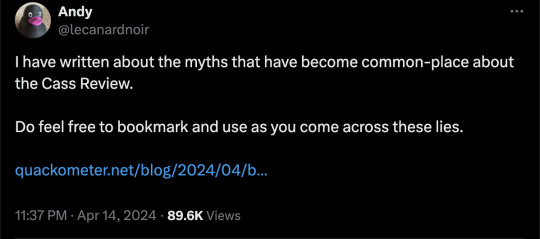
By: Andy L.
Published: Apr 14, 2024
It has now been just little under a week since the publication of the long anticipated NHS independent review of gender identity services for children and young people, the Cass Review.
The review recommends sweeping changes to child services in the NHS, not least the abandonment of what is known as the “affirmation model” and the associated use of puberty blockers and, later, cross-sex hormones. The evidence base could not support the use of such drastic treatments, and this approach was failing to address the complexities of health problems in such children.
Many trans advocacy groups appear to be cautiously welcoming these recommendations. However, there are many who are not and have quickly tried to condemn the review. Within almost hours, “press releases“, tweets and commentaries tried to rubbish the report and included statements that were simply not true. An angry letter from many “academics”, including Andrew Wakefield, has been published. These myths have been subsequently spreading like wildfire.
Here I wish to tackle some of those myths and misrepresentations.
-
Myth 1: 98% of all studies in this area were ignored
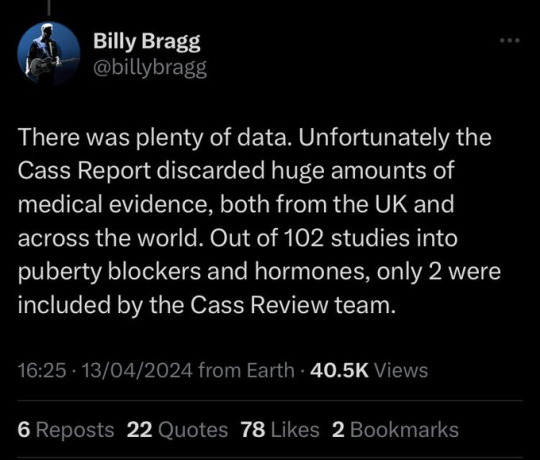
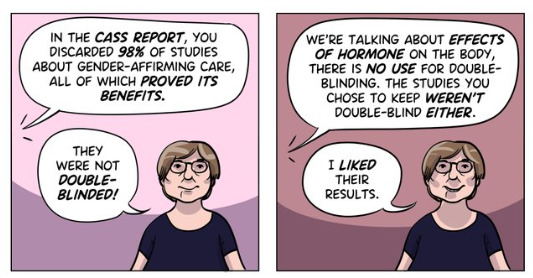
Fact
A comprehensive search was performed for all studies addressing the clinical questions under investigation, and over 100 were discovered. All these studies were evaluated for their quality and risk of bias. Only 2% of the studies met the criteria for the highest quality rating, but all high and medium quality (50%+) studies were further analysed to synthesise overall conclusions.
Explanation
The Cass Review aimed to base its recommendations on the comprehensive body of evidence available. While individual studies may demonstrate positive outcomes for the use of puberty blockers and cross-sex hormones in children, the quality of these studies may vary. Therefore, the review sought to assess not only the findings of each study but also the reliability of those findings.
Studies exhibit variability in quality. Quality impacts the reliability of any conclusions that can be drawn. Some may have small sample sizes, while others may involve cohorts that differ from the target patient population. For instance, if a study primarily involves men in their 30s, their experiences may differ significantly from those of teenage girls, who constitute the a primary patient group of interest. Numerous factors can contribute to poor study quality.
Bias is also a big factor. Many people view claims of a biased study as meaning the researchers had ideological or predetermined goals and so might misrepresent their work. That may be true. But that is not what bias means when we evaluate medical trials.
In this case we are interested in statistical bias. This is where the numbers can mislead us in some way. For example, if your study started with lots of patients but many dropped out then statistical bias may creep in as your drop-outs might be the ones with the worst experiences. Your study patients are not on average like all the possible patients.
If then we want to look at a lot papers to find out if a treatment works, we want to be sure that we pay much more attention to those papers that look like they may have less risk of bias or quality issues. The poor quality papers may have positive results that are due to poor study design or execution and not because the treatment works.
The Cass Review team commissioned researchers at York University to search for all relevant papers on childhood use of puberty blockers and cross-sex hormones for treating “gender dysphoria”. The researchers then graded each paper by established methods to determine quality, and then disregarded all low quality papers to help ensure they did not mislead.
The Review states,
The systematic review on interventions to suppress puberty (Taylor et al: Puberty suppression) provides an update to the NICE review (2020a). It identified 50 studies looking at different aspects of gender-related, psychosocial, physiological and cognitive outcomes of puberty suppression. Quality was assessed on a standardised scale. There was one high quality study, 25 moderate quality studies and 24 low quality studies. The low quality studies were excluded from the synthesis of results.
As can be seen, the conclusions that were based on the synthesis of studies only rejected 24 out of 50 studies – less than half. The myth has arisen that the synthesis only included the one high quality study. That is simply untrue.
There were two such literature reviews: the other was for cross-sex hormones. This study found 19 out of 53 studies were low quality and so were not used in synthesis. Only one study was classed as high quality – the rest medium quality and so were used in the analysis.
12 cohort, 9 cross-sectional and 32 pre–post studies were included (n=53). One cohort study was high-quality. Other studies were moderate (n=33) and low-quality (n=19). Synthesis of high and moderate-quality studies showed consistent evidence demonstrating induction of puberty, although with varying feminising/masculinising effects. There was limited evidence regarding gender dysphoria, body satisfaction, psychosocial and cognitive outcomes, and fertility.
Again, it is myth that 98% of studies were discarded. The truth is that over a hundred studies were read and appraised. About half of them were graded to be of too poor quality to reliably include in a synthesis of all the evidence. if you include low quality evidence, your over-all conclusions can be at risk from results that are very unreliable. As they say – GIGO – Garbage In Garbage Out.
Nonetheless, despite analysing the higher quality studies, there was no clear evidence that emerged that puberty blockers and cross-sex hormones were safe and effective. The BMJ editorial summed this up perfectly,
One emerging criticism of the Cass review is that it set the methodological bar too high for research to be included in its analysis and discarded too many studies on the basis of quality. In fact, the reality is different: studies in gender medicine fall woefully short in terms of methodological rigour; the methodological bar for gender medicine studies was set too low, generating research findings that are therefore hard to interpret. The methodological quality of research matters because a drug efficacy study in humans with an inappropriate or no control group is a potential breach of research ethics. Offering treatments without an adequate understanding of benefits and harms is unethical. All of this matters even more when the treatments are not trivial; puberty blockers and hormone therapies are major, life altering interventions. Yet this inconclusive and unacceptable evidence base was used to inform influential clinical guidelines, such as those of the World Professional Association for Transgender Health (WPATH), which themselves were cascaded into the development of subsequent guidelines internationally.
-
Myth 2: Cass recommended no Trans Healthcare for Under 25s
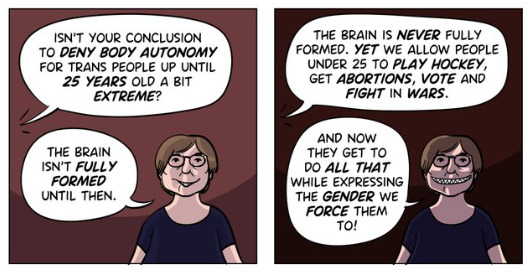
Fact
The Cass Review does not contain any recommendation or suggestion advocating for the withholding of transgender healthcare until the age of 25, nor does it propose a prohibition on individuals transitioning.
Explanation
This myth appears to be a misreading of one of the recommendations.
The Cass Review expressed concerns regarding the necessity for children to transition to adult service provision at the age of 18, a critical phase in their development and potential treatment. Children were deemed particularly vulnerable during this period, facing potential discontinuity of care as they transitioned to other clinics and care providers. Furthermore, the transition made follow-up of patients more challenging.
Cass then says,
Taking account of all the above issues, a follow-through service continuing up to age 25 would remove the need for transition at this vulnerable time and benefit both this younger population and the adult population. This will have the added benefit in the longer-term of also increasing the capacity of adult provision across the country as more gender services are established.
Cass want to set up continuity of service provision by ensure they remain within the same clinical setting and with the same care providers until they are 25. This says nothing about withdrawing any form of treatment that may be appropriate in the adult care pathway. Cass is explicit in saying her report is making no recommendations as to what that care should look like for over 18s.
It looks the myth has arisen from a bizarre misreading of the phrase “remove the need for transition”. Activists appear to think this means that there should be no “gender transition” whereas it is obvious this is referring to “care transition”.
-
Myth 3: Cass is demanding only Double Blind Randomised Controlled Trials be used as evidence in “Trans Healthcare”
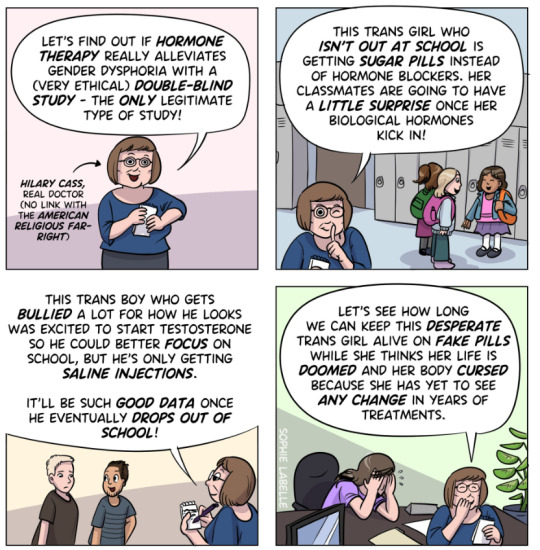
Fact
While it is acknowledged that conducting double-blind randomized controlled trials (DBRCT) for puberty blockers in children would present significant ethical and practical challenges, the Cass Review does not advocate solely for the use of DBRCT trials in making treatment recommendations, nor does it mandate that future trials adhere strictly to such protocols. Rather, the review extensively discusses the necessity for appropriate trial designs that are both ethical and practical, emphasizing the importance of maintaining high methodological quality.
Explanation
Cass goes into great detail explaining the nature of clinical evidence and how that can vary in quality depending on the trial design and how it is implemented and analysed. She sets out why Double Blind Randomised Controlled Trials are the ‘gold standard’ as they minimise the risks of confounding factors misleading you and helping to understand cause and effect, for example. (See Explanatory Box 1 in the Report).
Doctors rely on evidence to guide treatment decisions, which can be discussed with patients to facilitate informed choices considering the known benefits and risks of proposed treatments.
Evidence can range from a doctor’s personal experience to more formal sources. For instance, a doctor may draw on their own extensive experience treating patients, known as ‘Expert Opinion.’ While valuable, this method isn’t foolproof, as historical inaccuracies in medical beliefs have shown.
Consulting other doctors’ experiences, especially if documented in published case reports, can offer additional insight. However, these reports have limitations, such as their inability to establish causality between treatment and outcome. For example, if a patient with a bad back improves after swimming, it’s uncertain whether swimming directly caused the improvement or if the back would have healed naturally.
Further up the hierarchy of clinical evidence are papers that examine cohorts of patients, typically involving multiple case studies with statistical analysis. While offering better evidence, they still have potential biases and limitations.
This illustrates the ‘pyramid of clinical evidence,’ which categorises different types of evidence based on their quality and reliability in informing treatment decisions

The above diagram is published in the Cass Review as part of Explanatory Box 1.
We can see from the report and papers that Cass did not insist that only randomised controlled trials were used to assess the evidence. The York team that conducted the analyses chose a method to asses the quality of studies called the Newcastle Ottawa Scale. This is a method best suited for non RCT trials. Cass has selected an assessment method best suited for the nature of the available evidence rather than taken a dogmatic approach on the need for DBRCTs. The results of this method were discussed about countering Myth 1.
Explainer on the Newcastle Ottawa Scale
The Newcastle-Ottawa Scale (NOS) is a tool designed to assess the quality of non-randomized studies, particularly observational studies such as cohort and case-control studies. It provides a structured method for evaluating the risk of bias in these types of studies and has become widely used in systematic reviews and meta-analyses.
The NOS consists of a set of criteria grouped into three main categories: selection of study groups, comparability of groups, and ascertainment of either the exposure or outcome of interest. Each category contains several items, and each item is scored based on predefined criteria. The total score indicates the overall quality of the study, with higher scores indicating lower risk of bias.
This scale is best applied when conducting systematic reviews or meta-analyses that include non-randomized studies. By using the NOS, researchers can objectively assess the quality of each study included in their review, allowing them to weigh the evidence appropriately and draw more reliable conclusions.
One of the strengths of the NOS is its flexibility and simplicity. It provides a standardized framework for evaluating study quality, yet it can be adapted to different study designs and research questions. Additionally, the NOS emphasizes key methodological aspects that are crucial for reducing bias in observational studies, such as appropriate selection of study participants and controlling for confounding factors.
Another advantage of the NOS is its widespread use and acceptance in the research community. Many systematic reviews and meta-analyses rely on the NOS to assess the quality of included studies, making it easier for researchers to compare and interpret findings across different studies.
As for future studies, Cass makes no demand only DBRCTs are conducted. What is highlighted is at the very least that service providers build a research capacity to fill in the evidence gaps.
The national infrastructure should be put in place to manage data collection and audit and this should be used to drive continuous quality improvement and research in an active learning environment.
-
Myth 4: There were less than 10 detransitioners out of 3499 patients in the Cass study.

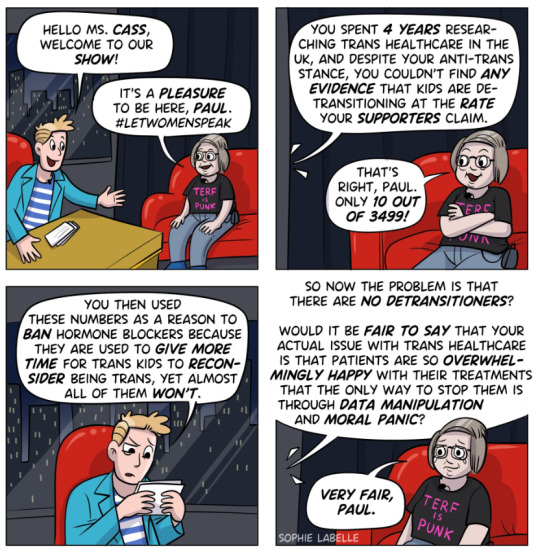
Fact
Cass was unable to determine the detransition rate. Although the GIDS audit study recorded fewer than 10 detransitioners, clinics declined to provide information to the review that would have enabled linking a child’s treatment to their adult outcome. The low recorded rates must be due in part to insufficient data availability.
Explanation
Cass says, “The percentage of people treated with hormones who subsequently detransition remains unknown due to the lack of long-term follow-up studies, although there is suggestion that numbers are increasing.”
The reported number are going to be low for a number of reasons, as Cass describes:
Estimates of the percentage of individuals who embark on a medical pathway and subsequently have regrets or detransition are hard to determine from GDC clinic data alone. There are several reasons for this:
Damningly, Cass describes the attempt by the review to establish “data linkage’ between records at the childhood gender clinics and adult services to look at longer term detransition and the clinics refused to cooperate with the Independent Review. The report notes the “…attempts to improve the evidence base have been thwarted by a lack of cooperation from the adult gender services”.
We know from other analyses of the data on detransitioning that the quality of data is exceptionally poor and the actual rates of detransition and regret are unknown. This is especially worrying when older data, such as reported in WPATH 7, suggest natural rates of decrease in dysphoria without treatment are very high.
Gender dysphoria during childhood does not inevitably continue into adulthood. Rather, in follow-up studies of prepubertal children (mainly boys) who were referred to clinics for assessment of gender dysphoria, the dysphoria persisted into adulthood for only 6–23% of children.
This suggests that active affirmative treatment may be locking in a trans identity into the majority of children who would otherwise desist with trans ideation and live unmedicated lives.
I shall add more myths as they become spread.
==
It's not so much "myths and misconceptions" as deliberate misinformation. Genderists are scrambling to prop up their faith-based beliefs the same way homeopaths do. Both are fraudulent.
#Andy L.#Cass Review#Cass Report#Dr. Hilary Cass#Hilary Cass#misinformation#myths#misconceptions#detrans#detransition#gender affirming healthcare#gender affirming care#gender affirmation#affirmation model#medical corruption#medical malpractice#medical scandal#systematic review#religion is a mental illness
387 notes
·
View notes
Text
ANNA BONESTEEL AND EVAN GREER at Them:
Pride Month is over. As the “LOVE IS LOVE” banners come down and companies lose the rainbow gradients from their logos, we’re faced with a painful truth: LGBTQ+ people, especially the most marginalized among us, are in the crosshairs of a queerphobic backlash that is targeting our health, our histories, and especially our youth. And things are getting worse, not better. According to NPR, half of all US states now ban gender-affirming care for people under 18. Eight states now censor LGBTQ+ issues from school curricula via “Don’t Say Gay” laws, and two more states are considering similar legislation this year. The number-one book targeted for censorship is a graphic novel memoir about gender identity.
This June, Democratic lawmakers marched in Pride parades and spoke on stages, vowing to protect our community and fight back against legislative attacks on queer youth. But some of these same lawmakers are actively pushing federal legislation that would cut LGBTQ+ youth off from resources, information, and communities that can save their lives. Currently, 38 Democratic senators support the Kids Online Safety Act (KOSA), a bill that is vocally opposed by many queer and trans youth, along with a coalition of human rights and LGBTQ+ groups. As a queer- and trans-led advocacy group focused on the ways technology impacts human rights, our organization, Fight for the Future, has seen bills like KOSA before: misguided internet bills that try to solve real problems, but ultimately throw marginalized people under the bus by expanding censorship and surveillance rather than addressing corporate abuses. KOSA’s most obvious predecessor is SESTA/FOSTA, a Trump-era bill that its supporters claimed would clamp down on online sex trafficking. Instead, the bill did almost nothing to accomplish its goal, and has actively harmed LGBTQ+ people and sex workers whose harm-reduction resources were decimated by the subsequent crackdown on online speech.
Like SESTA/FOSTA, some of KOSA’s supporters have positive intent. Many lawmakers and organizations support KOSA because they are concerned about real harms caused by Big Tech, like addictive design features and manipulative algorithms. But, also like SESTA/FOSTA, KOSA doesn’t touch the core issues with Big Tech’s extractive, exploitative business model. Instead, KOSA relies on a “duty of care” model that will pressure social platforms to suppress any speech the government is willing to argue makes kids “depressed” or “anxious.”
Under KOSA, platforms could be sued for recommending a potentially depression- or anxiety-inducing video to anyone under 18. We know from past experience that in order to protect their bottom line, social media companies will overcompensate and actively suppress posts and groups about gender identity, sexuality, abortion — anything they’re worried the Federal Trade Commission (FTC) could be willing to argue “harms” kids. How do you think a potential Trump administration’s FTC would use that kind of authority?
Other features of the bill stretch its censorship potential further. Despite language claiming that the bill does not require platforms to conduct “age verification,” to meaningfully comply with the law, platforms will have to know who is under 18. This means they’ll institute invasive age verification systems or age-gating, which can completely cut off access for LGBTQ+ youth who have unsupportive parents, and/or make it unsafe for queer people to access online resources anonymously. KOSA creates powerful new ways for the government to interfere with online speech. For this reason, the bill is like catnip to extreme right-wing groups like the Heritage Foundation, the coordinators of Project 2025, who have explicitly said they want to use it to target LGBTQ+ content. KOSA’s lead Republican sponsor, Marsha Blackburn, has also said in an interview she wants to use KOSA to protect minors “from the transgender.”
The Kids Online Safety Act (KOSA) purports to protect children, but in reality, it’s a censorship bill that would impact LGBTQ+ youth. #StopKOSA #KOSA
#Kids Online Safety Act#KOSA#Stop KOSA#Big Tech#Censorship#LGBTQ+#Anti LGBTQ+ Extremism#Age Verification#Internet#Internet Safety#Internet Freedom#Internet Censorship#Civil Liberties#Duty of Care
192 notes
·
View notes
Text
I've posted about this before but in the current climate, especially, a signal boost can only be a good thing.
There is an excellent organisation here in the UK that I have an ongoing donation to, Campaign Against Antisemitism.
From their website:
"HOW WE FIGHT ANTISEMITISM
Campaign Against Antisemitism consists of eight directorates which collaborate closely to expose and counter antisemitism through education and zero-tolerance enforcement of the law:
1. Investigations and Enforcement
We work closely with police forces around the country, the Crown Prosecution Service, regulatory bodies and the government to ensure that antisemitism is detected, investigated and punished with the full force of the law. We focus on criminal antisemitism and antisemitic acts committed by professionals or institutions which are subject to special regulation, such as lawyers, teachers, sportspeople and charities. We also provide training and advice to the authorities, whilst also scrutinising their performance and holding them to account when they fall short.
2. Awareness and Communication
Working closely with senior journalists and advertising professionals, we run proactive campaigns to ensure that the public is aware of anti-Jewish racism and the immense societal danger that it poses. Through our advocacy work we seek to mobilise public support for the fight against antisemitism, whilst also generating pressure on the authorities to pursue a policy of zero tolerance for antisemitism. We also provide information and comment to the media through our media centre.
3. Outreach and Education
We strive to reduce anti-Jewish prejudice by providing education and training to all in society who wish to find out more about being Jewish, antisemitism, and fighting racism. We also reach out to other minority communities and anti-racist groups so that we can work to strengthen each other.
4. Public Affairs
We have forged links with the government, local authorities, regulators, police forces and the Crown Prosecution Service, as well as with companies such as the major social networks. We meet at the highest levels to tackle the roots of antisemitism and ensure that the law is upheld effectively, consistently and firmly.
5. Mobilisation
Antisemitism is a societal problem and we believe that individuals should be at the forefront of the fight against antisemitism. We recruit, train and mobilise volunteers, empowering them to leverage their talent and expertise against antisemitism.
6. Litigation
We have recruited some of Britain’s most formidable and acclaimed legal minds. Our lawyers give their time to provide guidance on specific cases and also takes action to hold the authorities and private companies to account when they fail to act against antisemitism effectively. Our legal experts include specialists in criminal law, charity law, regulatory law, administrative law, employment law, media law and litigation.
7. Organisation and Finance
Our volunteers need central support in every area from systems administration to finance. Working with senior professionals, we ensure that our volunteers receive the support they need, and that our charity complies strictly with regulatory and financial requirements.
8. Fundraising
We are proud to operate with extremely low overheads, relying almost entirely on volunteers, however our work costs money, whether it is to pay court fees when we litigate, or to commission important research. We fundraise throughout the year to raise the sums needed to enable our work to continue."
They also have a podcast that recently aired its 100th episode, that I highly recommend. They talk about the current work they're doing, media bias, representation, and over 5 seasons have included interviews with Jewish public figures, Holocaust survivors, and more recently, survivors of Oct. 7 and family members of hostages:
https://antisemitism.org/podcast/
86 notes
·
View notes
Text
Muriel Stanley Venne, a trail-blazing Métis woman known for her Indigenous rights advocacy, has died at 87. Venne, born in Lamont, Alta., was one of the first appointees to Alberta's Human Rights Commission in 1973 and later served as chair. She founded the Women of the Métis Nation as well as Esquao, the Institute for the Advancement of Aboriginal Women. She also created programming for the Métis Nation of Alberta before serving as provincial vice president from 2008 to 2012.
Continue reading
Tagging: @abpoli @newsfromstolenland
#indigenous figures#indigenous women#mmiw advocates#first nations#métis#cdnpoli#canada#canadian politics#canadian news#canadian#alberta
51 notes
·
View notes
Text
Skyward Bound: The Willa Beatrice Brown Story ✈

Celebrating Black History Month, we honor Willa Beatrice Brown, a trailblazer in aviation and civil rights activism. Willa Brown, born in 1906 in Glasgow, Kentucky, shattered racial and gender barriers in the skies and became the first African American woman to earn a commercial pilot’s license in the United States. Her unwavering dedication to integrating aviation programs and empowering future pilots through education and advocacy has cemented her as a pivotal figure in American history.

Willa Brown’s journey began with a passion for flying, leading her to earn her pilot’s license in 1938. Together with her husband, Cornelius Coffey, she founded the Coffey School of Aeronautics in Chicago, where they trained African American men and women, providing a foundation for the illustrious Tuskegee Airmen during World War II.

Brown’s advocacy extended to her role as the first African American woman to receive a commission as a lieutenant in the Civil Air Patrol and her political endeavors to integrate the armed forces, culminating in President Harry Truman signing Executive Order 9981 in 1948 to desegregate the military.
For those interested in exploring more about Willa Beatrice Brown’s incredible life and impact, the National Archives holds a treasure trove of resources:
#Black History Month#African American History#National Archives#Women’s History#Willa Beatrice Brown#Willa B. Brown#Aviation#BHM#BlackHistoryMonth#tuskegee airmen
168 notes
·
View notes